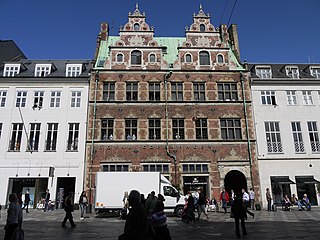Burmeister & Wain was a large established Danish shipyard and leading diesel engine producer headquartered in Copenhagen, Denmark. Founded by two Danes and an Englishman, its earliest roots stretch back to 1846. Over its 150-year history, it grew successfully into a strong company through the end of the 1960s. In the 1970s, global competitive pressures, particularly from the far east, began to take their toll. In 1980, B&W became MAN B&W Diesel A/S, part of MAN B&W Diesel Group, a subsidiary of the German corporation MAN AG, with operations worldwide. The company still maintains operations at three main sites in Denmark for manufacturing, servicing, and licensing of its two-stroke engines and complete propulsion systems.

Caspar Frederik (Friedrich) Harsdorff, also known as C.F. Harsdorff, was a Danish neoclassical architect considered to have been the leading Danish architect in the late 18th century.

Skindergade is a street in central Copenhagen, Denmark. Running roughly parallel to Strøget, to which it is connected through Jorcks Passage, it extends for approximately 400 metres from Gammeltorv to Købmagergade.
Events from the year 1854 in Denmark.

The Matthias Hansen House, formerly also known as the Schoustrup House, is a Renaissance-style townhouse on Amagertorv in central Copenhagen, Denmark. Built in 1616, it is one of few buildings of its kind which has survived the Copenhagen Fires of 1728 and 1795. The building is now home to a flagship store for the Royal Copenhagen porcelain factory.

Pressens Hus, home to the Danish Media Association, a membership organisation body representing printed and digital media industry in Denmark, is situated at Skindergade 7 in central Copenhagen. The building consists of a former commerce house from 1903 and a Modernist infill extension by Erik Korshagen from 1976. which was listed in 1992.

Valdemar Ingemann was a prolific Danish architect active during the late 19th and early 20th century. His works include the Royal Copenhagen Porcelain Manufactury in Frederiksberg, Copenhagen.

Niels Hemmingsens Gade is a street in the Old Town of Copenhagen, Denmark. It runs from the western part of Amagertorv in the south to Skindergade in the north and passes Gråbrødretorv on the way. The Church of the Holy Ghost is located in the street. The street is named after the 16th-century Lutheran theologian Niels Hemmingsen.

Christian Hasselbalch was a Danish industrialist and merchant. He founded Hasselbalch & Co.

Løve Apotek was the first pharmacy in Copenhagen, Denmark. It opened in 1620 and operated until its closing in 1971, for a total of approximately 350 years. For the entire duration of its existence, it was located at the corner of Amagertorv and Hyskenstræde. The most recent building that it occupied was built for the pharmacy in 1908.

From Copenhagen Stock Exchange is a monumental 1895 oil on canvas group portrait painting by Peder Severin Krøyer, featuring 50 representatives of the Danish commercial and financial industries gathered in the Great Hall of the Exchange Building in Copenhagen, Denmark.
Sigfred Goldschmidt was a Jewish Danish businessman.

Frederik Riise was a Danish photographer and exhibition curator. He was a noted portrait photographer and is also remembered for his numerous photographs of buildings, streets and monuments in Copenhagen.
Danstruplund is a country house and former estate situatedf at the hamlet of Lille Esbønderup, between Helsingør and Fredensborg, some 35 km north of Copenhagen, Denmark.

Sabinus Theodor William Halvor Seidelin was a Danish businessman and landowner. He founded the company S. Seidelin.

Theodor Wilhelm Wessel was a Danish businessman. He is remembered as one of the two founders of the Magasin du Nord chain of department stores.

Leaving the Table, also known as Dinner Party at the Morescos', is a 1906 oil-on-canvas group portrait painting by Laurits Tuxen depicting a dinner party in Danish businessman Jacob Heinrich Moresco's home north of Copenhagen. The painting was a gift to Moresco on the occasion of the 50th anniversary of his firm. Many of the 45 people seen in the painting are well-known businessmen, politicians or other peers of the time.

Georg Emil Tuxen was a Danish naval officer.

The Grosserer-Societetet was a society for wholesale merchants in Copenhagen founded by law in 1742. Since 1714, it was possible to acquire citizenship as a wholesaler in the city. Grosserer-Societetet was reorganized in 1817. In 1987 the association was replaced by the Danish Chamber of Commerce.

Amagertorv 11/Læderstræde 11 is a Neoclassical property situated on the shopping street Strøget in central Copenhagen, Denmark. Constructed in 1798–1802 as part of the rebuilding of the city following the Copenhagen Fire of 1795, it owes its current appearance to two renovation undertaken in 1884 and 1903. The property was from around 1810 to 1845 owned by Gerson Melchior, owner of Moses & Søn G. Melchior. His sons Moses Melchior and Moritz G. Melchior, who would eventually continue the family firm, and Israel B. Melchior, an engineer and photographer, grew up in the building. In 1856, Melchior's heirs sold the property to wholesaler Sabinus Seidelin, whose trading firm S. Seidelin was subsequently operated from the rear wing. In 1903, S. Seidelin relocated to a new head office at Skindergade 7.

















